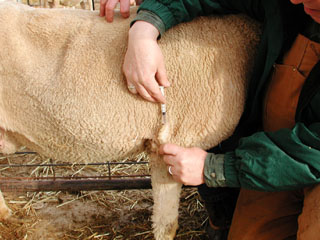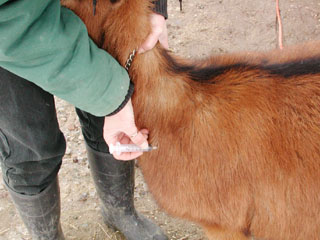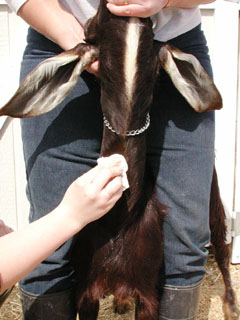The two most common
routes to administer injections are intramuscularly (IM) and subcutaneously (SQ
or SC). A few products are given orally (per os - PO), intravenously (IV), or
intranasally (IN). Giving vaccines or injections by the improper route can
result in failure of the product and may result in local reactions.
Subcutaneous (SQ or SC): A 1-inch needle of 18-20 gauge diameter should
be used. The loose skin on the side of the neck or behind the elbow is a good
location for SQ injections. These injections are given just below the skin, but
not into the muscle. Substances injected SQ are not picked up by the blood
supply as quickly as with IM injections, but greatly reduce carcass blemishes.
To avoid accidental intravenous (IV) administration, pull on the plunger to make
sure no blood appears in the syringe. If blood appears, pull the needle
completely out and re-insert the needle in a new site.
 |
|
|
| This
picture shows one location for a SQ injection. It is being
administered behind the elbow. |
|
 |
|
|
| This
picture shows the proper location for a SQ injection in the neck
region. |
|
Intramuscular (IM): Injections given IM are picked up by the blood supply
and spread to all tissues of the body very rapidly. A needle 1 to 1 ½ inches in
length and 18-20 gauge in diameter is recommended for making IM injections. The
best location to give injections is in the heavy muscles of the neck. To
reduce carcass damage and potential nerve damage, avoid the rear quarters
whenever possible. It is best to give no more than 15 mLs at any one site.
To avoid accidental intravenous (IV) administration, pull on the plunger to make
sure no blood appears in the syringe. If blood appears, pull the needle
completely out and re-insert the needle in a new site.
 |
|
|
| The
area outlined by the white triangle can be used for IM injections. |
|
 |
|
|
| In
goats, IM injections in the neck region can be difficult. A muscle
mass found in the area shown by the needle and syringe can often be
used. Injections given here seem to be well tolerated. |
|
First,
elevate the animal’s head slightly, placing the syringe (without the needle)
or dosing gun containing the medication at the side and back of the mouth. Next,
discharge the contents of the syringe or gun. Finally, hold the animal until all
of the product has been swallowed. See pages C60 and C174 for additional
administration techniques.
Intravenous (IV): Injections given IV are spread to all tissues of the
body extremely rapidly. This is important in cases where the animal may require
medications or fluids immediately because of dehydration or sickness. Situations
of diarrhea, milk fever (hypocalcemia), grass tetany (hypomagnesemia), or
pregnancy toxemia often require immediate IV fluids. When giving injections or
fluids IV, use a needle 1 to 1 ½ inches in length and 18-20 gauge in diameter.
The best location to give large volume IV injections is in the jugular vein in
the neck. In lactating dairy goats, the milk vein can sometimes be used to
inject small volumes of fluid. If an injection is given in a milk vein, use a
small gauge needle to help reduce the possibility of excessive blood loss.
 |
|
|
| This
picture shows an easy way to restrain a sheep or goat when trying to
administer an injection IV or when trying to collect blood out of
the jugular vein. |
|
 |
|
|
| Clean
the jugular region of the neck with alcohol. This will sanitize the
area and make the vein easier to see. On animals with a lot of hair
or wool, it sometimes helps to also clip the jugular area. |
|
|
|
|
|
| The
thumb of one hand is placed on the lower portion of the vein. Once
the vein is fully distended, the needle should be placed in a
downward direction. Every effort should be made to avoid the carotid
artery that is located just behind the jugular vein. No
injection should ever be given in the carotid artery
(see below for additional details). Once the needle is in place, the
lower hand can be removed. |
|
 |
|
|
| With
the lower hand removed, no blood should come out of the needle. If
blood continues to squirt out of the top of the needle, it could be
in the carotid artery. If there is any question on the location of
the needle, it should be removed and the process started over again.
If everything seems correct, blood can be drawn or an injection can
be given. |
|







